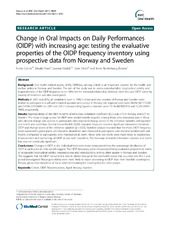Change in Oral Impacts on Daily Performances (OIDP) with increasing age: testing the evaluative properties of the OIDP frequency inventory using prospective data from Norway and Sweden
Peer reviewed, Journal article
Published version
Permanent lenke
https://hdl.handle.net/1956/8469Utgivelsesdato
2014-05-31Metadata
Vis full innførselSamlinger
Originalversjon
https://doi.org/10.1186/1472-6831-14-59Sammendrag
Background: Oral health-related quality of life, OHRQoL, among elderly is an important concern for the health and welfare policy in Norway and Sweden. The aim of the study was to assess reproducibility, longitudinal validity and responsiveness of the OIDP frequency score. Whether the temporal relationship between tooth loss and OIDP varied by country of residence was also investigated. Methods: In 2007 and 2012, all inhabitants born in 1942 in three and two counties of Norway and Sweden were invited to participate in a self-administered questionnaire survey. In Norway the response rates were 58.0% (4211/7248) and 54.5% (3733/6841) in 2007 and 2012. Corresponding figures in Sweden were 73.1% (6078/8313) and 72.2% (5697/ 7889), respectively. Results: Reproducibility of the OIDP in terms of intra-class correlation coefficient (ICC) was 0.73 in Norway and 0.77 in Sweden. The mean change scores for OIDP were predominantly negative among those who worsened, zero in those who did not change and positive in participants who improved change scores of the reference variables; self-reported oral health and tooth loss. General Linear Models (GLM) repeated measures revealed significant interactions between OIDP and change scores of the reference variables (p < 0.05). Stratified analysis revealed that the mean OIDP frequency score worsened in participants who became dissatisfied- and improved in participants who became satisfied with oral health. Compared to participants who maintained all teeth, those who lost teeth were more likely to experience improvement and worsening of OIDP across both countries. The two-way interaction between country and tooth loss was not statistically significant. Conclusions: Changes in OIDP at the individual level were more pronounced than the percentage distribution of OIDP at each point in time would suggest. The OIDP frequency score showed promising evaluative properties in terms of acceptable longitudinal validity, responsiveness and reproducibility among older people in Norway and Sweden. This suggests that the OIDP instrument is able to detect change in the oral health status that occurred over the 5 year period investigated. Norwegian elderly were more likely to report worsening in OIDP than their Swedish counterparts. Disease prevention should be at focus when formulating the health policy for older people.
Beskrivelse
Erratum published: BMC Oral Health. 2015 May 12;15(1):58
Utgiver
BioMed CentralTidsskrift
BMC Oral HealthOpphavsrett
Copyright 2014 Gülcan et al.; licensee BioMed Central Ltd.Ferda Gülcan et al.; licensee BioMed Central Ltd.

